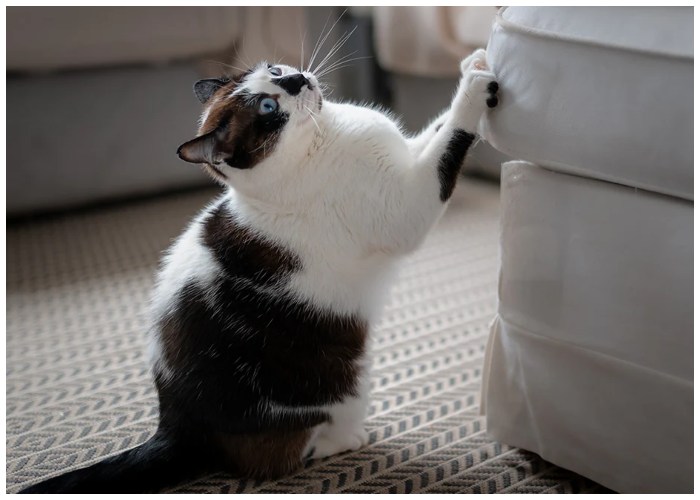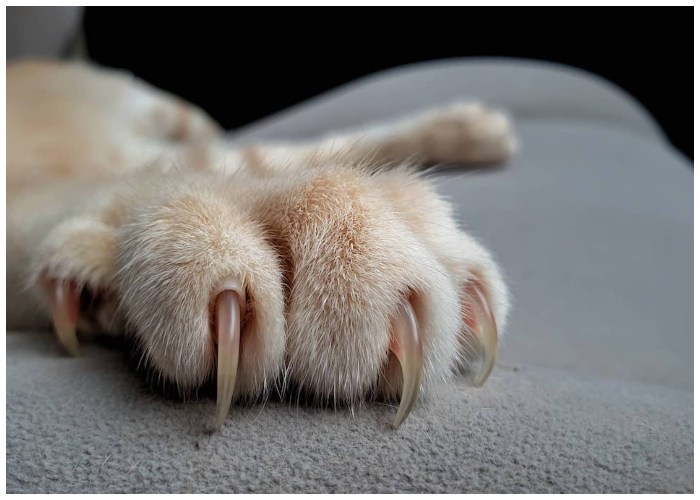Scratching is a natural and healthy behavior for cats. While it can be frustrating when your cat scratches furniture, it’s important to understand why they engage in this activity. Cats scratch for several reasons, including maintaining claw health. Their claws grow outwardly, and scratching helps them shed the outer layers, keeping their claws sharp and healthy. Without scratching, a cat’s claws could grow abnormally and cause discomfort.
In addition to claw health, scratching provides cats with exercise and allows them to stretch and strengthen their upper bodies. Scratching also plays a role in marking territory. Cats have scent glands in their paws, and when they scratch, they leave both a scent and visual mark, which makes them feel secure in their environment. Furthermore, scratching can be a way for cats to relieve stress or express playfulness, contributing to their mental and emotional well-being.
Training Your Cat to Scratch Appropriately
Training your cat to scratch suitable surfaces is crucial. Instead of trying to stop your cat from scratching altogether, provide alternatives that are more acceptable than furniture. One of the most effective methods is to introduce scratching posts. These posts can mimic the textures and surfaces cats love to scratch while offering a designated spot for them to indulge in this behavior. It’s important to choose a scratching post that suits your cat’s preferences. Vertical and horizontal posts cater to different scratching habits, and adding variety with options like sisal rope, cardboard, or wood can help attract your cat.
If your cat prefers scratching carpets, offering a horizontal scratching surface may be ideal. Place these posts in areas where your cat is already scratching, like near the couch or bed, to increase the likelihood they will use them. Over time, you can gradually move the posts to other areas, but keeping them near their favorite scratching spots can lead to better success.

Making Furniture Less Appealing to Cats
In addition to offering a scratching post, making your furniture less attractive to your cat can help protect your belongings. Covering your furniture with tightly tucked sheets, plastic, or aluminum foil can discourage your cat from scratching. Another option is to use double-sided sticky tape, which many cats dislike touching. You can also spray your furniture with cat-safe scents, like citrus or apple cider vinegar, as cats tend to avoid these odors.
Remember, punishing your cat for scratching furniture is not effective and could harm your relationship with your pet. Instead, gently redirect your cat to the scratching post and praise them when they use it.
Caring for Your Cat’s Nails
Trimming your cat’s nails regularly can help minimize damage from scratching. Start by gently handling your cat’s paws, getting them used to having their claws touched. When your cat is comfortable with this, use sharp nail trimmers designed for cats to clip the tips of their nails, avoiding the quick (the pink area where the blood vessels are). Trim their nails every few weeks to keep them in good shape.
If your cat is resistant to having their nails trimmed, ask your veterinarian for help or consider claw caps, which are soft rubber covers that fit over your cat’s nails. These caps can prevent damage from scratching without causing your cat discomfort.

Why Declawing Is Not the Answer
Declawing, a surgical procedure that involves amputating the last bone of each toe, is not a recommended solution. Declawing can lead to chronic pain and behavioral problems, including increased aggression and improper litter box use. Many regions have banned the practice due to its cruelty. Instead of declawing, focus on training and providing suitable scratching alternatives for your cat.
Conclusion: A Balanced Approach to Scratching
Understanding your cat’s need to scratch and providing appropriate outlets can help preserve your furniture while keeping your cat happy and healthy. By offering scratching posts, making furniture less appealing, and keeping your cat’s nails trimmed, you can manage this natural behavior without causing stress to your pet. If you’re still struggling, don’t hesitate to reach out to a veterinarian or animal behaviorist for additional advice.
Ah, the wedding cake—often the centerpiece of the reception and a sweet ending to the big day. While everyone loves indulging in a delicious cake, choosing what to serve can be overwhelming. From flavors and designs to toppers and serving timing, there’s a lot to consider. Don’t worry, though! We’ve gathered some essential wedding cake questions and tips to help you navigate this sweet decision with ease.